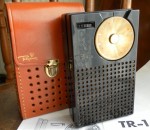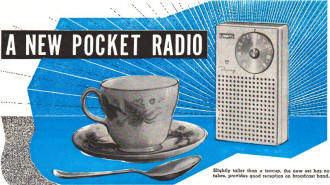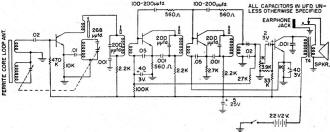A New Pocket Radio - Regency TR-1 |
||
A New Pocket Radio
The first pocket radio to use transistors instead of tubes has been produced by Regency of Indianapolis and is being marketed currently in the N.Y. and Los Angeles areas. Slightly taller than a teacup, "Model TR-1" uses four transistors and a germanium diode in a compact super-heterodyne circuit. Within its case, measuring 3" x 5" x 1 1/4", the unit contains its own battery power supply, a built-in bar antenna, and a tiny PM speaker. This first commercial all-transistor set owes its successful design, in part, to the high performance transistor developed by Texas Instruments Incorporated of Dallas, who are the first people to mass produce a low cost, high gain, high frequency germanium transistor. The transistor is a grown junction n-p-n type. Used in the new pocket radio, it provides power gains of 34 decibels and 40 decibels in the intermediate frequency and audio stages, respectively. Such figures have previously been attainable only in the laboratory. As shown in the schematic below, the circuit employs only four transistors and one germanium diode. Laboratory models of similar sets have hitherto used almost twice as many transistors. The first transistor, TI223, serves as a frequency converter (local oscillator and mixer). Stations are tuned in by a miniature two-ganged capacitor. The i.f. stages employ two transistors, TI222 type and three tiny i.f. transformers. Audio detection is accomplished by a germanium diode. The audio signal is developed across a miniature 1000 ohm volume control and thence fed to the fourth transistor, TI210, which serves as an audio amplifier. Sufficient power is developed by this stage to drive the diminutive PM speaker. Slightly taller than a teacup, the new set has no tubes, provides good reception on broadcast band. Featured in this set is the advantage of long battery life. Because the power consumption is only a fraction of that required for a comparable vacuum tube unit, it was possible to eliminate one battery as well as to reduce the size of the one remaining and still extend its life. This, in turn, effected a reduction in weight and is expected to reduce battery replacement cost. Another advantage claimed by the manufacturer is the elimination of tubes and the problem of tube replacement. While the hot filament or cathode in a vacuum tube is continually consumed during operation, no similar phenomenon occurs in transistors. Except for physical damage, transistors will last indefinitely. The new radio was designed by the firm of Painter, Teague and Petertil, industrial designers. Miniaturization of components was achieved by a number of organizations. The speaker was produced by Jensen of Chicago. The tuning capacitor was made by the Radio Condenser Company of Camden, N.J. The Vokar Corporation of Dexter, Mich. contributed the i.f. transformers. The volume control was made by Chicago Telephone Supply Corporation of Elkhart, Indiana. Centralab of Milwaukee engineered a very small ceramic capacitor. Components were assembled by a semi-automatic process using printed wiring and dip soldering techniques. Sanford Electronics is handling distribution in New York, while West Coast distribution is being undertaken by Gough Industries, Inc. of Los Angeles.
Posted October 14, 2022 |
||



